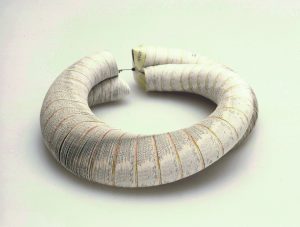Since the last decades of the previous century, the paper has interested many artists as a means of creative expression. The aesthetic qualities and the technical potential of that material can exert a great attraction, so much so that in some cases it becomes the exclusive element of the artistic research.
In the eighties, Stefano Arienti, an Italian visual artist, chooses paper as the protagonist of his work. He uses materials from everyday life such as comic books, telephone directories, railway timetables and musical scores, which he enjoyed cutting, bending and drilling to create sculptures with a playful and brainy flavour.
When in 1998 Elena Levi Palazzolo, the ELP Studio’s gallerist, asks him to create a series of original jewels, Arienti decides to be faithful to his material. So he makes long necklaces to wrap around the neck, composed by pieces of tracing paper, torn, folded and often covered with spray varnish.
His ornaments deny the eternity that the jewel generally possesses, making it paradoxically more precious exactly for its fragility and the skilful intervention of the artist.

Nel Linssen, Bracelet, 2000, reinforced paper, elastic thread. Preziosa 2005

Nel Linssen, Necklace, paper, nylon thread, 1999. Preziosa 2005
During the same period, since 1986, the Dutch Nel Linssen, guest of Lucca Preziosa 2005, starts to develop a design method based on a type of intuitive experimentation that recalls origami art. Linssen folds patiently and interwoven strips of coloured paper plastic-coated linked by an elastic thread.
That ability to “weave” the paper through different ways to fit it together, allows her to obtain surfaces that appear vibrant in the changing of the plots. The necklaces twist on themselves with the magnetic sinuosity of the snake, and the changing colours of the cards increase that effect.
These ornaments look even more spectacular when you start to manipulate them: bracelets unfold over the whole forearm, necklaces turn on themselves, always seeming different. Experiencing the optical impression, Linssen can instil in the viewer a sort of hypnotic desire to touch and to observe the jewel insistently to catch the secrets of its logical construction.

Janna Syvänoja, Necklace, recycled paper, steel wire, 2004. Preziosa 2005
Janna Syvänoja‘s jewels, required for Lucca Preziosa 2005, give a similar impression of mobility and even deceive the eye about the material they are made of. They look like big and wonderful shells, but really, they are sheets of recycled paper: newspapers, books, telephone directories, cut and joined by a steel wire. She achieves that effect by imitating the organic structure of the natural world, giving new life and ethical meaning to a material used in the industrial field. Strips are linked together to create a small-waves surface, while the hidden text of the paper makes the colours shaded.
Similar constructive reasoning animates the impressive and more recent works by Daniele Papuli, who, since 1995, dedicates himself only to paper to create design objects, installations, sculptural dresses and jewellery. His lamellar vortices appear vibrant and robust masses, reversing the idea of paper as a fragile and perishable material.
Recently, the number of jewellery makers who dedicate their surveys to paper is growing, and the outcomes are full of inventiveness and artistic sensibility.



